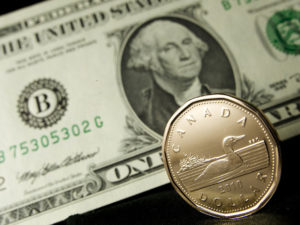 The loonie, as the Canadian dollar is best known, fell against its US counterpart, despite data showed US consumer confidence decreased this month. However, greenbacks demand was supported after it became clear that US home prices rose in line with analysts expectations, one month after capping the largest advance in almost 8 years.
The loonie, as the Canadian dollar is best known, fell against its US counterpart, despite data showed US consumer confidence decreased this month. However, greenbacks demand was supported after it became clear that US home prices rose in line with analysts expectations, one month after capping the largest advance in almost 8 years.
USD/CAD hit a session high at 1.1097 at 15:14 GMT, after which the pair consolidated at 1.1089, adding 0.24% for the day. Support was likely to be found at February 19th low, 1.0911, while resistance was to be met at February 24th high, 1.1143.
The Conference Board research group announced the results from its monthly survey on US consumer confidence, with the corresponding index coming in at 78.0 in February, trailing analysts projections of a smaller decline to 80.0 and down from 80.7 in the preceding month.
Consumer confidence, as an indicator, provides clues regarding the tendency in consumer spending in the country, while the latter accounts for almost two thirds of nation’s Gross Domestic Product.
However, the S&P/Case-Shiller Home Price Index, which measures the change in selling prices of homes in 20 of the largest cities in the US, rose at an annualized pace of 13.42% in December from a year ago, compared to a 13.71% increase in the previous month, the biggest increase since February 2006. Analysts had predicted a 13.38% advance. On a monthly basis, US home prices declined 0.1% in December, in line with analysts forecasts and after falling 0.1% in November.
Meanwhile, the loonie received some support last week after official data showed the nation’s inflation rate accelerated at a 1.5% annualized rate in January, which is the highest pace in 1-1/2 years amid surge in home heating costs.
However, demand for the Canadian dollar was pressured after a report showed the nation’s retail sales registered the largest one-month decline in a year. Retail sales declined 1.8% to 40.2 billion Canadian dollars or $36 billion in December, while analysts predicted a 0.4% drop. In November, retail sales increased by 0.5%.
In addition, Statistics Canada reported on February 19 that wholesale sales declined 1.4% to 49.6 billion Canadian dollars ($45.3 billion) in December, in comparison with a 0.4% decrease estimated by experts. November’s reading received downward revision to a 0.2% drop.
The eastern parts of Canada were hit by a severe ice storm in December, which caused power outages and left thousands of homes in Ontario, Quebec and the Atlantic provinces without electricity.
According to Bank of Montreal chief economist Doug Porter, cited by Bloomberg, the Canadian gross domestic product probably shrank in December because of the storm.
The Canadian economy is struggling to recover from an almost two-year slowdown and the latest reported data did show that the economy grew at an annualized 2.7% pace in the third quarter. However, economists surveyed by Bloomberg News predict that growth slowed to 2.5% in the fourth quarter, ahead of Statistics Canada quarterly GDP report, scheduled to be released on Friday, February 28th.





